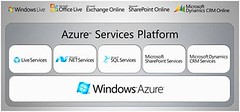Into the intersection of contracting IT budgets due to the financial crisis and gathering momentum for cloud computing steps Microsoft with Azure, a platform that allows developers to create cloud-computing architectures run from (where else?) Microsoft servers.

Into the intersection of contracting IT budgets due to the financial crisis and gathering momentum for cloud computing steps Microsoft with Azure, a platform that allows developers to create cloud-computing architectures run from (where else?) Microsoft servers.The announcement at its Professional Developers Conference (PDC) in LA, may have aspired to Redmond's past second-mover launches, but rather than serving notice with the ominous understatements of the past that made the likes of Netscape or Sega quiver in fear, the shivers from the Googleplex and elsewhere around the cloudscape, thus far, appear notable mostly by their absence.
That Redmond would pull back the curtain on Azure -- aka Red Dog -- at PDC was expected and perhaps that muted the impact of this presumed salvo across the bow of Google's App Engine and Amazon's Elastic Compute Cloud from Microsoft's Software + Services strategy.
To hear Ray Ozzie tell it, Red Dog is "setting the stage for the next 50 years of systems." As to how you should calibrate your IT budget to pay for the next 50 years of services, you'll need to wait on that as pricing isn't available. However, the metric that is available is 2% -- as in sales of Vista increased 2% last quarter. You can almost hear Ballmer yodeling, "There's gold in them thar clouds!"
If there is gold rush on, Microsoft will be mining it from four layers:
Layer zero -- Microsoft's Global Foundation Services (GFS), the platfrom for Microsoft Live and Online Services
Layer one -- Azure
Layer two -- Services running on Azure
Layer three -- Azure-hosted applications
Rendered visually (sans GFS):

Despite the careful orchestration of the announcement, Microsoft already stumbled on one detail -- registering Azure as a trademark. It seems, they nabbed the domain more than a decade ago, but never filed for it with USPTO.
More From bMighty: Cloud Computing For Your Business
About the Author(s)
You May Also Like





